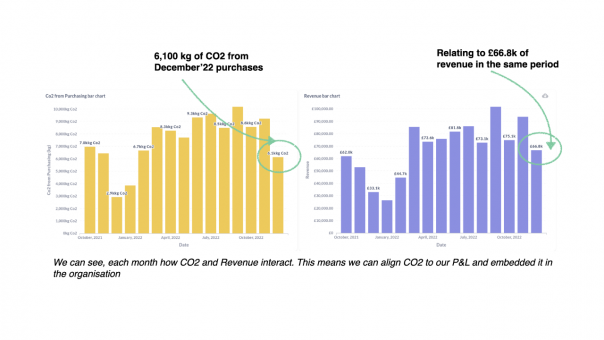
Anyone reading the headlines, or indeed looking at their financials from last year, could be forgiven for not putting climate change at the top of the agenda. 2022 was ‘yet another’ year of unprecedented economic shocks including triple digit energy cost rises, double digit food inflation, significant labour wage increases and rising interest rates.
However the climate challenge is still very much with us, across education, health, care, prisons, defence, local government and even the corporate hospitality sector. Winning contracts is increasingly down to how we, as supply chain partners, can help our clients achieve their carbon reduction ambitions, not just our ability to serve food and deliver exceptional service. As operators we know our destination, but until now have been missing the map and compass to help get us there.
For the catering industry, the carbon is on the plate
Carbon dioxide and equivalent gases originating from food purchased in the public sector is at an almost unimaginable scale. Research conducted by Public Sector Catering magazine in April 2020 estimated that 25% of the population in the UK are fed by the public sector, accounting to 2.1bn meals each year.
Given that over 80% of the carbon footprint within catering businesses is driven from the ingredients, namely what’s on the plate, these 2.1bn meals equate to a significant carbon footprint. The question for us as catering providers must be; how big is the footprint, what ingredients are driving it and how can we deliver change. As the old maxim goes, if you can't measure it, you can't manage it.
So far, caterers, like the broader hospitality sector, have suffered from insufficient or well-intentioned but misguided tools to help them. Carbon accounting has a place in the broader climate conversation, but not when talking about food. This is because carbon accounting lacks the sufficient detail required to understand where we are ‘spending our carbon’ and therefore what ingredient changes will really move the dial.
A simple example is that a £1,000 invoice from a wholesale supplier will yield a generic carbon ‘spend’ irrespective of what was on the invoice. Whether you are buying minced beef or chickpeas, it all looks the same through the lens of carbon accounting.
Another approach has been the limited introduction of carbon labelling, giving a traffic light system based on the CO2 rating of dishes. This can help consumers but its efficacy is questionable and insight very limited. In 2019 Babakhani, Lee & Dolnicar investigated customer attention paid to carbon labels using eye-tracking technology.
Their report found that little attention was paid to such labels and they argued it was unlikely to impact food choices. Ultimately we’ll need to report on and reduce the carbon footprint of our operations. It gets us nowhere to simply say a falafel wrap is ‘good’, a chicken sandwich ‘worse’ and a beef lasagne ‘bad’.
We need a compass, we need a map …
The solution must be one which looks at purchasing using both commercial and carbon lenses. A new platform has been built with the destination in mind and an operator's P&L at its core. Zedible enables head chefs, operations managers or purchasing leads to understand which ingredients are driving CO2 and therefore what changes will yield the biggest reduction in footprint whilst reporting on the financial cost, or indeed reduction, associated with making these ingredient purchasing changes.
The platform was built by operators from the catering sector and their own experience in scaling an ethically-minded restaurant chain. The approach at Zedible is to make CO2 a KPI, aligning carbon to the P&L and thus embedding it within the organisation. Once measured in both absolute and ingredient specific terms, operators can track their carbon intensity relative to revenue – see Figure 1.
And Figure 2, a case study derived from real life data, shows how a drop in carbon intensity was achieved as a direct result of the removal of lamb meatballs in place of a pea protein product, a change which didn’t sacrifice sales or margin.
The platform allows such insights to also be viewed in the context of purchasing category and downstream supply chain because navigating towards Net Zero will require full supply chain engagement across the board.
Mapping the road ahead
Because Zedible gives SKU level detail, operators get a full understanding of where their efforts should be focused when it comes to purchasing decisions. For example by switching from Full Fat Milk to Semi Skimmed Milk, a Bristol based catering company was able to reduce the second biggest driver of CO2 by 23%, a change which had no discernible impact on customer experience or negative impact on margin – see Figure 3
Public sector caterers can finally set sail …
For our industry to get behind the carbon reduction challenge set by our clients, we need to be able to navigate a way forward which drives revenue, bolsters margin and reduces Co2 intensity at the same time. What once felt like an impossible set of opposing demands, now feels both understandable and wholeheartedly achievable. Indeed despite it still being winter, our longer term future is not looking as bleak as we might have been led to believe. Now we just need to set sail.